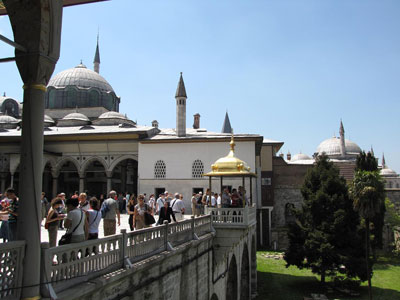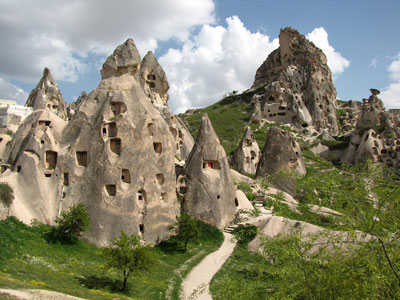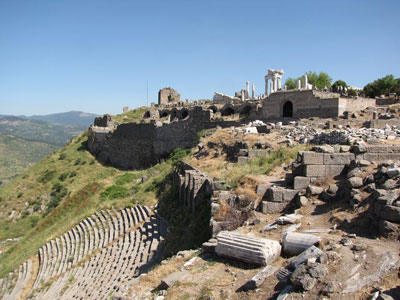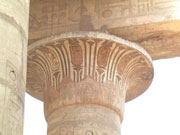TOUR NEWS - ANCIENT TURKEY MAY 2009
The B.C. Archaeology Tour of Ancient Turkey for May 2009 was a great success, with a small but very enthusiastic group. This included: Margaret Debenham, Denise McKenzie, Susan Hayward, Bronwyn Ison, Shane and Tim Woodburn and Llewellyn Jones. The tour was led by Michael Birrell, and we had a great local Turkish guide called Serkan Bakilan who kept us very informed about modern life in Turkey.
I arrived in Istanbul before the group, making my way from Athens via Thessalonica. This gave me the chance to revisit parts of northern Greece which I had seen many years ago, and to also explore new sites. Thessalonica contains an excellent archaeological museum with fascinating artefacts from the Macedonian culture as well as the Roman period. The ancient remains in the city include a superb Arch of Emperor Galerius with reliefs showing his eastern campaigns, his tomb (the Rotunda) and palace. I hired a car and explored the Macedonian capital city of Pella and the Royal Tombs at Vergina - the display of the golden treasures and the tombs is fabulous. I also drove up to the top of Mt Olympus and went for a walk in the magnificent alpine forest (where I even heard an eagle far off!) and also explored the extensive ruins of the city of Dion.
 |
 |
Topkapi Palace |
The 'Kings Gate' at Hattusas, the ancient Hittite capital |
The 2009 Tour of Ancient Turkey began on the 11th May and ran till 30th May. I met the group at Istanbul International Airport and after checking into our hotel we saw some of the major Byzantine monuments of Istanbul. This includes the antiquities of the Hippodrome and the awe inspiring Basilica Cisterns, the huge underground water storage facilities created by the Emperor Justinian. We have lunch in a nearby restaurant. The afternoon was spent in the magnificent Haghia Sophia Church. We had a very pleasant dinner with views over the city. The next day was spent in Topkapi Palace, home to the medieval Sultans and the Ottoman royal court. The palace is famous for its marvellous harem rooms, lined with sumptuous Iznik tiles. In the afternoon we visited the Grand Bazaar and explored some its incredible maze of shops.
The following morning we flew to Ankara. Here we saw the Temple of Augustus and after lunch we visited the war museum and impressive mausoleum of Kamal Ataturk, founder of the modern nation of Turkey. We had a nice fish dinner and I tasted the ultimate in desserts: melted halva!! Even I couldn't finish it! Next morning we visited the Ankara Museum of Anatolian Civilizations, home to a fascinating collection of artefacts from the Palaeolithic Era down to the Roman period. Of particular interest are the neo-Hittite reliefs from Carcamesh and the Assyrian letters from Kanesh. We had a pleasant lunch in a converted house within the medieval fort of Ankara with panoramic view over the city. In the afternoon we drove NE of Ankara to our hotel near Bogazkale. The next part of the tour was dedicated to the ancient Hittites; we took a short trip by bus to Hattusas, and spent the morning in the ancient city. Rain threatened at first but soon the sun shone brightly for us. Highlights of the visit included the royal citadel, the Great Temple and the impressive city gates. After lunch in a nearby caf� we visited the rock-cut shrine of Yazilikaya which preserves remarkable representations of the Hittite pantheon. Our final Hittite site was Alaca Huyuk, an ancient fortified Hittite site with tombs, which we saw the following morning. The sphinx gate is very impressive!
Our driver Onur then took us south to the fascinating region of Cappadocia, famous for its natural 'fairy chimneys' made from volcanic pumice. We explored some of the chimneys and climbed up into one of them before visiting the old city of Uchisar where we climbed to the top of the pumice castle for a superb view over the whole of Cappadocia. The following day we went to see the painted churches of Goreme and visited a carpet bazaar where we saw carpets being woven and the extraction of silk from cocoons. Despite my best intentions, I also bought a carpet. After lunch (delicious cheese and spinach Gozleme - a type of pancake) we explored the ruins of the ancient settlement of Zelve, home to a monastic community in the Middle Ages. The inhabitants cut their houses and the monasteries from the local volcanic pumice and protected their dwellings by movable boulders. In the evening we went to the Sari Han, an ancient Selcuk caravanserai, to see a performance of whirling dervish dancing.
 |
 |
The 'fairy chimneys' of Cappadocia |
The theatre at Priene |
The next morning we had some free time to rest and relax in Urgup township. We then drove to Ankara for our flight to Izmir. We were met by our new driver Ahmet and travelled the short distance by bus to the town of Selcuk. We stayed at the Hotel Nazar, a pleasant family run hotel with roof-top restaurant, which was our home for the following 6 nights and a base for exploring the sites of the local area.
Our first day in the area was spent at the world heritage listed ruins of the ancient city of Ephesus. We started early to avoid the inevitable crowds from the tour boats - we wandered around the city, admiring the marble monuments of Curetes Street, the temple of Hadrian, the library of Celsus and the justly famous theatre. As a special part of our program, we visited the ruins of the private houses which preserve beautiful frescos and mosaics - the opus sectile (inlaid marble) walls are remarkable! On the way back we stopped briefly to look at the remains of the Artemis Temple, originally one of the Seven Wonders of the World, but now largely robbed away.
The next morning we visited the ruins of the ancient Hellenistic city of Priene, located in the Meander River valley. This superb site includes a picturesque agora, town council hall, theatre, and magnificent Temple of Athena, set on a rocky promontory and surrounded by palm trees. We had lunch by the sea in Kusadasi. In the afternoon we visited the local Archaeological Museum, best known for its intact statues of Artemis. We somehow avoided a spectacular hail storm in the process but thought the roof of the museum was going to come down! The next day was free for everyone to explore and do there own thing - I went to Izmir to see the Archaeological Museum (more antiquities!). The next day we visited the ancient cities of Miletus and Didyma. We saw the wonderful theatre, the agora and the well preserved Baths of Faustina. After lunch we saw the awe inspiring ruins of the Temple of Apollo, one of the largest temples in the Classical world and once home to a famous oracle. On our way back, we saw the Basilica of St John and the Isa Bey Mosque in Selcuk.
Our last day in the Selcuk area was spent at the ancient site of Aphrodisias, cult centre of the famous goddess of love. The site is renowned for its remarkably well preserved Roman stadium, its theatre and agora (marketplace). A highlight of the visit to the museum was a newly opened gallery displayed the spectacular relief sculpture from the Sebasteion (Temple of Augustus).
We packed our bags, sorry to be saying farewell to the Nazar Hotel, and headed north to Bergama where we saw the royal burial mounds and the Temple of Serapis (the 'Red Basilica'). After lunch in the town, we spend the afternoon in the fascinating Archaeological Museum of Bergama which preserves magnificent sculpture and other artefacts from the local excavations. The following day we explored the superb ruins of Pergamon. Perched on the summit of a precipitous mountain the city developed as a major centre of art and culture. Unlike the majority of 'tourists' we walked down the hill to see the royal palace, theatre, library and temples. The mosaics of Building Z are particularly fine. In the afternoon we visited the enclosure of Asclepius, god of Medicine.
 |
 |
The Turkey Tour group in Aphrodisias |
The acropolis of Pergamon |
The next morning we travelled north by bus from Bergama to Troy. On the way we pass through some beautiful scenic country and stopped to photograph a shepherd and his herd of goats - Serkan ended up riding his donkey! After lunch we explored the ruins of Troy which was famously excavated by the German entrepreneur Heinrich Schliemann in the late 19th Century. We took about 3 hours to see the ruins. In the afternoon, we had a short bus ride to �anakkale, stopping en route to see some WWI gun emplacements.
We were up early the next day to cross the Straits of the Dardanelles for our visit to the Gallipoli Peninsula. We drove to Cape Hellas and saw the Turkish war memorial with its beautiful glass grave memorials. We then explored the WWI battle fields of Gallipoli including Anzac Cove, Lone Pine and Chanuk Bair. We had the chance to explore these poignant locations and appreciate the incredible hardships of the fighters on both sides. In the afternoon we drove north to Istanbul.
Our final two days were spent exploring some of the scenic wonders of Istanbul. We took the ferry from the Istanbul wharf up the Bosphorus Straits to the entrance to the Black Sea. This gave us the chance to enjoy a magnificent view of the city and the wonderful houses along the way (I haven't quite decided which house to buy yet - the multi-million dollar price tag may be a problem!). We climbed up to Anadolu castle for a view of the Black Sea. In the afternoon we had a coffee in the Spice Bazaar and then went to the top of Galata Tower for a breathtaking view across the Golden Horn.
On our last day we explored the Istanbul Archaeological Museum which houses artefacts from Troy and other significant sites in Turkey. We had lunch in a restaurant with views over the Bosphorus and then went to see the Blue Mosque, constructed in the early 17th Century by the Ottoman Sultan Ahmed I. Dominating the local area of the city, it is one of the great buildings of Islamic Istanbul. In the afternoon there was free time for last minute shopping. A very enjoyable tour with an easy going and interested group.
Michael Birrell

